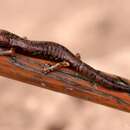Description
provided by AmphibiaWeb articles
A single male specimen measures 40.4 mm in SVL, 75.0 mm in TL. Four female specimens range from 35.3-49.7 mm in SVL, with an average SVL of 43.9 mm and average TL of 75.3 mm. Bolitoglossa cataguana has 13 costal grooves. The snout is truncated when viewed dorsally and is rounded in profile. Labial protuberances are well-developed. Mental gland is absent. Suborbital groove and postorbital groove are distinct. Gular fold is well-defined. The female holotype has 6 premaxillary teeth located just posterior to the lip, as well as 51 maxillary teeth that extend to the posterior half of the orbit and are aligned with the premaxillary teeth but separated by a small gap. Twenty-one vomerine teeth are present in two arched series, extending to the edges of the internal nares. The forelimbs are relatively slender. Hind limbs are broader than long. The fingers are moderately webbed, except for one to two phalanges on the third finger. The toes are free of webbing. The relative length of fingers is 1
Townsend, J. H., Butler, J. M., Wilson, L. D., Austin, J. D. (2009). ''A new species of salamander in the Bolitoglossa dunni group (Caudata: Plethodontidae: Bolitoglossinae) from Parque Nacional Montana de Yoro, Honduras.'' Salamandra, 45(2), 95-105.
Distribution and Habitat
provided by AmphibiaWeb articles
B. cataguana is known from the frontier community of Cataguana in the Lower Montane Wet Forest formation between 1800 to 2080 m above sea level on the western side of the Parque Nacional Montaña de Yoro, central Honduras. The holotype was collected from a trail above Quebrada Cataguana in the Parque Nacional Montaña de Yoro, at 1850 m elevation. All specimens were collected from lightly disturbed Mixed Cloud Forests (Townsend et al. 2009).
Life History, Abundance, Activity, and Special Behaviors
provided by AmphibiaWeb articles
Two juveniles were collected in March, on small plants about 0.5 m above the ground. An adult female was seen sleeping during the day under a log. Other specimens were collected during the night when the animals were active on a steep hillside. They were all found on plants 0.5 to 3.0 m above the ground (Townsend et al. 2009).

